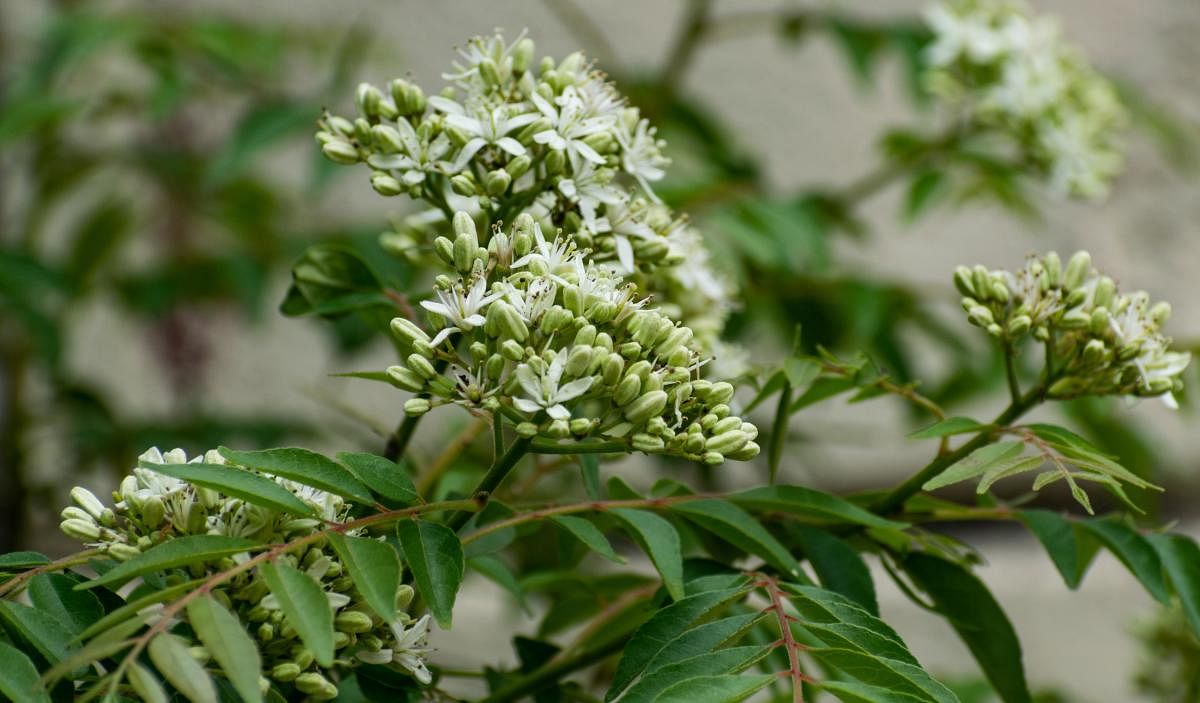
Last week, a friend of mine asked me to suggest a nursery where she could procure a curry leaf plant. I did not have an immediate answer because I did not remember buying one. Curry leaf is an integral part of South Indian cooking for the aromatic leaf adds a distinct flavour to food. It also has been a permanent plant in my kitchen garden. A drink I make using the tender leaves is my favourite. I crush the tender leaves with salt and ginger, stir them well in
buttermilk, and add some ice cubes. It aids in digestion and cools the body in summer. I also make a fragrant oil using the leaves which keeps my hair healthy.
The curry leaf plant is a shrub that grows nearly three meters high and requires four to five hours of sunlight every day. It sprouts fresh leaves in summer, followed by flowers, and then fruits. The raw fruit is unpalatable, while the fully matured purple ones are both pungent and sweet to taste. Koels, barbets, and crows consume the fruits. They digest the pulp while the pit is undigested and reaches the ground through their droppings. Moist soil helps in germinating the seed.
The homegrown advantage
Most of the fertilizers needed for the curry plant can be found at home. It is an age-old agricultural practice to feed it with rice-washed water and diluted buttermilk. Raw rice washed water and diluted buttermilk contain protein, crude fibre, amino acids, calcium, iron, phosphorus, potassium, and lactic acid bacteria. The bacteria improve soil health. Calcium helps in the development of a good root system and helps fix nitrogen in the soil. Phosphorus helps in the growth and potassium helps in resisting diseases. Since it is a foliage plant it also requires a fertilizer rich in nitrogen. Compost does wonders to the plant. Adding it regularly every month gives it rich foliage. It is also susceptible to aphids, spider mites, and mildew. Mildew spreads fast on the cusp of seasons. To treat it, mix baking soda in water in a ratio of 1:100 and spray it once every 10 days.
Pruning the tips regularly while sourcing them for cooking coaxes new branches. The plant hosts the Mormon butterfly caterpillars, which consume all the leaves. It springs back with fresh leaves once the caterpillars complete their metamorphosis.
Where do you get a good curry leaf plant? Homegrown plants are more aromatic than the ones found in plant nurseries. Ask your gardening friends, neighbours, or relatives if they have a sapling at home for you. If you don’t have any, buy them from a plant nursery but ensure the leaves are fragrant. I’ve heard people trying to germinate the seed manually but in vain. Propagating by cuttings works well, provided you grow in soil that is rich in nutrients. At my home, there are always saplings growing here and there. I collect them when they are nearly half a foot in height and transfer them to pots or give it away to friends who need them.
Presence of soil
Another friend asked me how to propagate Impatiens walleriana. Impatiens walleriana is an impatient flowering plant. The ripe seeds are sensitive to touch and readily disperse with a crackling noise. Hence, the name “impatient.” Because of its dispersing property, the plants spread further and further away from the main plant. The probability of a plant growing in your garden is high if one of your neighbours has it. You don’t have to buy them, they plant themselves freely in your garden. Unfortunately in my friend’s house, the plant was in a pot on a balcony and there was no place for the seed to fall and germinate. I asked her to move it close to her other pots on the floor so that the dispersed seeds could land in one of them.
When I look back at my childhood, the stark difference between then and now is the presence of soil. The Earth was open to the sky and filled with wild plants and flowers. Lantana, Mysore Mallige, Woodrose, Balloon Vine, and Button Daisies were some plants you would find everywhere. Through these years, we have masked our cities with concrete, and it has been unhelpful to plants that thrive by dispersing their seeds. Having patches of soil here and there will make a huge difference. So, if you are building a new house or remodifying your existing one, make sure there is some soil around you.
Until next time, happy gardening.
Motley garden is your monthly kaleidoscopic view into a sustainable garden ecosystem.
The author believes that gardening is not just about plants and how to nurture them. It is also about bees, butterflies, insects, flies, and bugs that make it their home. She is on social media as @Neelavanam